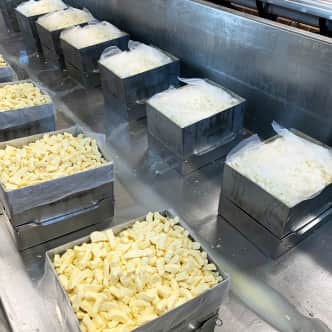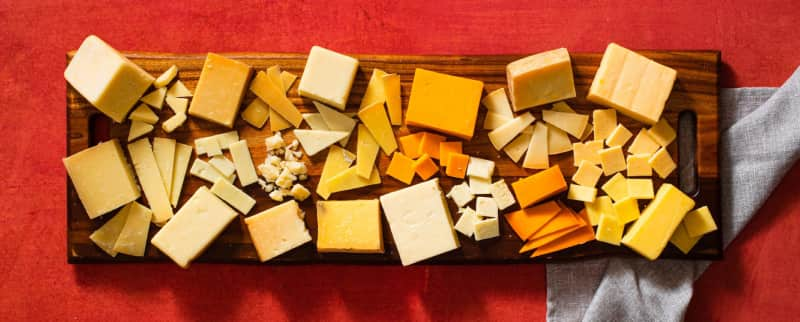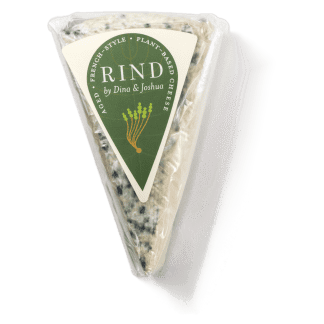I grew up on the border of Wisconsin, so I love cheddar and always keep a block (or two) in my fridge. Even so, I was an adult when I realized how vast the world of cheddar is. I was a new cheesemonger tasked with cutting big 40-pound blocks and smaller wheels of cheddar into individual pieces. When I cut into Cabot Clothbound Cheddar, an artisanal cheese from Vermont, I realized it was covered in strips of fabric that had to be peeled away. It’s obvious in retrospect—clothbound means “wrapped in fabric”—but I’d never seen anything like it. The cheese’s crumbly texture, caramel sweetness, and earthiness were also a pleasant, eye-opening surprise.
What Exactly Is Artisanal Cheddar?
Although most of us have a clear idea of what cheddar looks and tastes like, it’s a difficult cheese to define succinctly. “It is all things to all people,” as The Oxford Companion to Cheese (2016) puts it. It’s available in an incredible variety of shapes, sizes, flavors, textures, colors, and ages. We’ve written before about sharp cheddar and extra-sharp cheddar. For this story, I focused on artisanal cheddars—that is, those that are made by hand—so I went to Shelburne Farms in Shelburne, Vermont, to shadow head cheesemaker Helen Cowan and observe the process firsthand.


At Shelburne Farms, the cheesemaking team allowed ATK Reviews editor Kate Shannon to suit up and help them make a batch of cheddar.
The milk used to make cheddar can be raw—as it is at Shelburne Farms—but it’s typically pasteurized. The milk is heated and then specific strains of cultures are added for flavor. To tint the cheese bright yellow or deep shades of orange, makers sometimes add annatto (a flavorless dye derived from the seeds of the achiote tree). Enzymes or rennet are added to make the milk thicken and form a gel the consistency of soft yogurt. The gel is cut into cubes that are drained, heated, and allowed to fuse together into curds.


Cheddar cheese gets its name from "cheddaring," a process of forming the curds into long blocks (left) and then cutting them into rectangles that are repeatedly stacked and flipped. Finally, those rectangles are milled into small pieces and packed into forms (right).
Next comes the step that gives the cheese its name: cheddaring. The curds are drained, pressed together, and cut into rectangular slabs. To remove moisture and ensure that the eventual cheese has a uniform and elastic texture, the slabs are stacked and turned at regular intervals. At Shelburne Farms, Cowan and cheesemaker Sam Zinner methodically flipped over each slab of curds and also alternated its position in the stack. They then fed the slabs through a machine that resembled a wood chipper, producing curds roughly two inches long. Finally, they salted the curds and packed them into stainless-steel forms that were pressed to remove still more moisture. For aging, the cheeses are removed from the forms and moved to underground caves or large walk-in refrigerators. Depending on the size and style of the cheddar, aging lasts months or even years.
Cheese Cultures Influence Style
When the cheeses are young or “green,” Cowan says, we would “mostly taste milk, butter, lactic acid, and salt.” As the cultures act on the cheese, “they break down the big milk proteins and butter fats into smaller and smaller pieces—and these pieces are what our taste buds can pick up on.” Geography influences which cultures are used and which specific flavors develop. In and around Wisconsin people favor “milky sweet” and balanced cheddar, explained Gordon Edgar, a California-based cheesemonger and author of Cheddar: A Journey to the Heart of America’s Most Iconic Cheese (2015). New Englanders love sharp, bitter, even sulfury cheddar that Edgar aptly describes as “bitey.”
Americans have a penchant for sweet things, so there’s been an uptick in sweeter cheddars in recent years. Prairie Breeze is perhaps the best-known example. Its cultures develop a distinct sweetness tempered by pleasant sharpness. Beecher’s Flagship is another sweet-sharp cheddar that kept our tasters going back for another bite.

Cheddar cheesemakers are also experimenting with cultures used to make other styles of cheese. The 100-year-old Widmer’s Cheese Cellars newest cheese, Matterhorn Alpine Cheddar, is made with traditional cultures and those commonly used to make Gruyère or Emmentaler. As Joe Widmer explained, cheddar and Alpine cheeses have complementary flavors and are aged for similar amounts of time. The Matterhorn does indeed have characteristic cheddar tang and the sweet, nutty flavor of an Alpine cheese.
Block Cheddar versus Clothbound Cheddar
How cheddar is shaped and aged has an enormous influence on its flavor and texture. There are two main formats: “block cheddars” and “clothbound cheddars.” However, they’re not produced in equal numbers. Dean Sommer, cheese technologist at the University of Wisconsin–Madison’s Center for Dairy Research, estimates that 99 percent of all cheddar made in America is block cheddar.

Block cheddars are vacuum-sealed in plastic, so they lose very little moisture and can age an incredibly long time. You can find block cheddars aged 12 or even 15 years, though 6 months to 3 years is more common. They are creamy and consistent in texture and develop sharp, sweet, and tangy flavors and sometimes that controversial sulfury note.
Clothbound (or “bandaged”) cheddars are wrapped in fabric and then coated with melted lard. “Bandaged cheddars continue to lose moisture during the aging process,” said Sommer, and the cheese is exposed to “oxygen that dramatically affects the chemistry of flavor production.” Additionally, flavorful yeast, molds, and bacteria grow on the rinds. The cheeses become firmer and crumblier, with more varied and concentrated earthy, sweet, fruity, and savory flavors. Especially near the rind, they’re earthy. Grafton Clothbound Cheddar can taste of both mushrooms and lemon; Bleu Mont Dairy Bandaged Cheddar has a hazelnut-like toastiness.
Despite the extremely precise production conditions, there’s an element of unpredictability when making cheddar. Cheesemakers test and evaluate their cheeses to determine how long to age them. A batch can develop an exceptionally satisfying crunch (from tyrosine crystals) and clothbound cheeses in particular may have a surprising new flavor. Rinds may not form properly, resulting in minor cracks or fissures (see “Are cheddar cheese blemishes bad?”). Edgar said that some shoppers at the San Francisco–area store where he works seek out clothbound cheddars with fissures because the flavor is uniquely punchy.

Which Cheddar(s) Are Right for You?
We chose 13 artisanal American cheddars to highlight. They are white or orange, block or clothbound, made by century-old companies or those started a decade or two ago. Given that they are all excellent in their own way, we’ve opted to list them in alphabetical order rather than rank them. Each would be great on a cheese plate or to turn an afternoon snack into a special occasion. Dive in to learn more and see how American cheddar makers are making the cheese their own.





 Buy at Murray's
Buy at Murray's


















